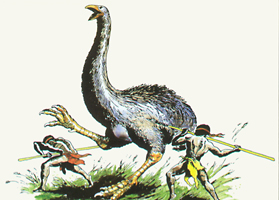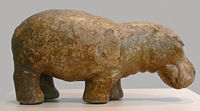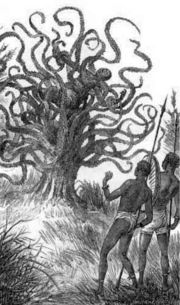Madagascar’s Cryptids
Posted by: Loren Coleman on February 24th, 2008

Harry Trumbore’s drawing of Madagascar’s kalanoro, from The Field Guide to Bigfoot and Other Mystery Primates.
New species of lemurs keep being discovered in Madagascar. But there’s a long history of other cryptids being reported from the world’s fourth largest island.

Besides the big three (Kalanoro, Elephant Bird, and Man-Eating Tree) that have historically been most discussed in cryptozoological and cryptobotancial circles regarding Madagascar, what lesser zoological cryptids are discussed from there? What other strange animals exist in the literature, many of which were noted in passing at Cryptomundo, after I first published information from near that corner of the world in relationship to the alleged U. S. Navy SEALs video of mystery apes that looked like the Kalanoro?
How about the Kilopilopitsofy and the Kidoky?
William R. Corliss writes: “In 1995, D.A. Burney and Ramilisonia interviewed elderly natives about their knowledge of the Kilopilopitsofy and Kidoky. Both of these animals are mentioned in the historical accounts and folklore of Madagascar between the mid-1600s and late 1800s. The testimonies collected by Burney and Ramilisonia enabled them to provide tentative indentifications of these two mystery animals, both of which may still survive today.”

The Kilopilopitsofy
A striking feature of the accounts of this mysterious animal is the consistency of the details. All the accounts we have collected stress that the animal is nocturnal, grunts noisily, and flees to water when disturbed. Likewise, there is general agreement that it is cow-sized, hornless, dark in color, and has a large mouth with big teeth.
Corliss observes: “These data agree with the old descriptions of the mangarsahoc (1661), the tsy-aomby-aomby (1882), and the Ombyrano (1912). One animal fits all of these accounts: the dwarf hippopotamus (Hippopotamus lemerlie), supposedly extinct for over 1,000 years.”
The Kidoky
This animal’s description is decidedly lemur-like. It was compared to the sifaka by all the interviewees who described it, although all insisted that it was not the same animal… It is much larger…perhaps 25 kg. It is usually encountered on the ground and may flee on the ground rather than taking to the trees…Its whooping call is suggestive of an indri.
Again, Corliss speculates: “The Kidoky is probably the giant aboreal lemur (Palaeopropithecus), known only from subfossils 1,000 or more years old.”
Source: Burney, David A., and Ramilisonia; “The Kilopilopitsofy, Kidoky, and Bokyboky: Accounts of Strange Animals from Belo-sur-mer, Madagascar, and the Megafaunal ‘Extinction Window’,” American Anthropologist, 100:957, [Corliss incorrectly cites this as 1999], 1998.
For those having access to university libraries, you may be interested in finding this article:
“The Kilopilopitsofy, Kidoky, and Bokyboky: Accounts of Strange Animals from Belo-sur-mer, Madagascar, and the Megafaunal ‘Extinction Window'”
American Anthropologist
December 1998, Vol. 100, No. 4, pp. 957-966
Abstract available at Anthrosource
Thanks to anthroman for pointing out the above correct citation.
Also, let me mention Strange Ark’s online regional guide to cryptids has a list of African cryptids at this location.
For Madagascar, sorting through Chad Arment’s list, the following cryptids are noted:
Lemurs: Unknown species, giant species
Reported from Madagascar
Heuvelmans 1986; Shuker 2000a; Shuker 1998d
Lemur: unknown miniature species
Reported from Tsingy de Bemaraha reserve, Madagascar
Shuker 1998d
Giant Fossa
Folklore from Madagascar
Discover article [?]
Pygmies: Kimos
Reported from Madagascar
Heuvelmans 1986
Feline: “Lions”
Reported from Madagascar
Shuker 1989
Madagascan dwarf hippo: Kilopilopitsofy
Reported from Madagascar
Shuker 2000a
Giant tortoise
Reported from southwest Madagascar
Eberhart 2002
Long-snouted Moth
Hypothesized from Madagascar
Bille 1995



An old wood carving of the Man-Eating Tree of Madagascar.
About Loren Coleman
Loren Coleman is one of the world’s leading cryptozoologists, some say “the” leading living cryptozoologist. Certainly, he is acknowledged as the current living American researcher and writer who has most popularized cryptozoology in the late 20th and early 21st centuries.
Starting his fieldwork and investigations in 1960, after traveling and trekking extensively in pursuit of cryptozoological mysteries, Coleman began writing to share his experiences in 1969. An honorary member of Ivan T. Sanderson’s Society for the Investigation of the Unexplained in the 1970s, Coleman has been bestowed with similar honorary memberships of the North Idaho College Cryptozoology Club in 1983, and in subsequent years, that of the British Columbia Scientific Cryptozoology Club, CryptoSafari International, and other international organizations. He was also a Life Member and Benefactor of the International Society of Cryptozoology (now-defunct).
Loren Coleman’s daily blog, as a member of the Cryptomundo Team, served as an ongoing avenue of communication for the ever-growing body of cryptozoo news from 2005 through 2013. He returned as an infrequent contributor beginning Halloween week of 2015.
Coleman is the founder in 2003, and current director of the International Cryptozoology Museum in Portland, Maine.










Very interesting! Thanks, Loren!
It looks like Madagascar is the place to be. I am still facinated by the man-eating tree drawing . I’m sure if i actually seen a carniverous tree such as this, i would want to get a closer look and therefore get eaten! I will be teaching a class on carniverous plants next year so i am trying to research the myths and legends as well as the actual facts on these wonderful plants!
Very interesting, that drawing of the Kalanoro resembles some drawings of the Chupacabras.
very cool. Hey, the link to the navy seal video took me to the article, but there wasn’t a video to be found (and I just got cable internet). I would love to actually find plants like that man eating tree. After all, it goes against everything we are taught that life on this planet has to be.
the Masola National Park is Madagascar`s largest remaining lowland rain forest, most of it still largely unexplored, a place where more lemur species await to be discovered. It would be nice to come up with a Dwarf Hippo or a Pygmy Hippo. Perhaps many more Frogs and Chameleons as well.The Bronx zoo this spring will open up with it`s Lemur exhibit this spring a must visit
Interesting article, Loren, as always.
I love the Man-eating Tree!!!
Some of these animals, like the dwarf hippo and giant lemur mentioned, have only been considered extinct for a thousand years, which is really a blink of the eye in geological terms. There are plenty of examples of creatures being rediscovered that had “disappeared” for longer than that, and the idea that a creature could survive past its supposed extinction date only a thousand years ago is not completely outlandish. I would say it is not entirely implausible that these species could still be out there in the remote corners of the island. I actually think that Madagascar could prove to be harboring a good deal of new species. I would even be more bold and say that finding a new genus is in the cards. Who knows, with all of the specially evolved indigenous animals that we already know of inhabiting the island, maybe we will find something truly spectacular and unique in the coming years.
An animal thought extinct for 1,000 years (and thus potentially only half that time) could easily remain in folklore, could it not?
Both mystery-man and sschaper make good points. Neither a folklore memory, nor an actual survival, of an animal species over a thousand years would be that unusual. These kind of cryptids (i.e. ones that are known to have existed) are always more likely than ones for whom there is no obvious evidence of their having existed in prehistory (i.e. – and i hate to say it – bigfoot).
Shumway- what do you mean a carnivorous tree would be “against everything we are taught that life on this planet has to be”? Says who?
Interesting, as always. One thing did catch in my craw, however; the use of the word “subfossil”. I guess I should get used to the fact that if geologists were as scientific about language as they are about rocks, the word fossil would be used more accurately…and the inaccurate use of language (my own mistakes not withstanding) leads to inaccurate concepts and error in thought.
This is something I share with good old Isaac Asimov who was vexed by our use of the word “venusian” when applied to anything regarding the planet Venus, where in fact it should be consistent with the language system from which it is derived. If that were done we’d call stuff about Venus venereal…and since we associate that with sexual disease, one can see how it was just easier to avoid the conflict as it resided in the mind of the less educated.
By the way, the description regarding this “sub-fossil” should have been “non-mineralized”. Does submarine mean not yet completely marine? No.
Fossil derives from the latin word describing the activity of digging and since originally most fossils were “dug up” not simply because they were preserved by mineralization and replacement., but of course, that’s what it was taken to mean by those for whom language is not always a reflection of a logical and orderly system, such as science exemplifies. OK…I’m done venting for the time being.
Mystery Man your quite right, i even hope that one of the Elephant Bird Genra, about the size of a chicken still eixts.
I agree with things-in-the-woods about the so called “man eating tree”. There are many precedents for carnivorous plant life in the natural world, and this new cryptid tree is merely taking the same concept and magnifying it to a larger size. Botany is not my specialty, but if smaller plant life has adapted to take advantage of a meat eating diet, I suppose a tree might do the same if it was efficient enough and there was a selective edge to be had by doing so.
The one thing that I see that would be a challenge for a carnivorous tree is catching such large prey and making sure it stays caught. The wood carving representation depicts a tree that seems to use long, flexible vines almost like the tentacles of an octopus. Plants just do not have musculature like animals and as such are somewhat limited in their movement options. True, some carnivorous plants move with a surprising speed when snapping shut, and other plants such as ivy definitely spread tendrils at a good rate, but the type of tentacle-like branches shown here that are fast and dexterous enough to ensnare a human being seem implausible in comparison. I suppose they could have a strong adhesive substance to bind a human or other large animal before slowly pulling them in, but a fast moving tentacle of the sort that could quickly lash out to grab people or animals and actually hold onto them would be very odd indeed in light of what we see in other known carnivorous plants.
Of course, in theory there are a lot of ways that a meat eating tree could possibly secure its prey and it is a good topic to speculate on. However, it seems to me that any means of catching, holding, and digesting such large prey would require enormous amounts energy on the tree’s part. Perhaps the energy required to be expended by a plant to catch and digest man sized prey, as well as maintain its large mass, outweighs any benefits of a meat eating diet at this size, and so we see carnivorous plants regulated to the much smaller sizes of known species. Sure some meat eating plants, like the “rat eating plant” mentioned here recently, eat surprisingly large animals, but there is no known plant life that eats any prey even approaching the size of a human being. This leads me to think that maybe there could be a biological or evolutionary reason why large meat eating plant-life, like trees, aren’t favored and haven’t developed. Maybe there are factors, such as energy investment in relation to selected advantages, that impose the apparent size limit on carnivorous plant life seen so far.
All in all I must admit I’m pretty skeptical of the man eating tree, but I won’t say it is impossible. If it is out there, though, it would indeed be a very odd and startling find.
The man eating tree thing is intriguing…It could have a poisonous sap or some sort of anesthetizing sap that could lure in prey and then trap it…hey I’m just using my imagination, but I think the venus fly trap has a sweet odor or some such thing to draw in prey (those more learned in that area please correct me…).
While odd and more in the realm of sci-fi so far, I would not rule out the possibility!
The December 2007 issue of Wildlife Conservation is “Titled small wonders, big Threats in Madagascar”.
Helen Crowley, director of WCS Madagascar Program. “we have been working in Madagascar for 13 years as a key partner in the national and international effort to conserve the countrys unique wildlife”.
springheeledjack- venus fly traps produce a sent to luer its prey, as well as sundews. The insect is attracted by a sweet smell released by the leaf or by the glue glissening in the sun.
Another carniverous plant the “cobra plant” in the” pitcher plant family “has a sweet smelling bulb. When a bug lands on the cobra’s tongue and follows the sweet smell of nector into the bottom of the plant; it gets caught. Yummy ! There is also a lot of intersesting information on the web as well.
When you think about it, herb plants have been used for centuries to mask odors or create scents used in cerimonies or rituals. there are also trees in the jungles that produce poisonous fruits, as well as poisonous sap. There is a sap from one of the rainforest trees that local tribes use for poison to put on the tips of their arrows. I believe that plants have to adapt to changes in this world to survive just as animals and humans do. possibly a long time ago in a galaxy far away ,Just kidding…… Possibly plants from centuries ago could have used poison to get prey. I read an article on line about apple trees. Human bones were found tangled in with the roots of the tree. Probably just a natural occurance Also found in cemetaries as well. Never the less facinating becouse i am sure the tree absorbed some nutrients from the bodies. weather it new it or not.